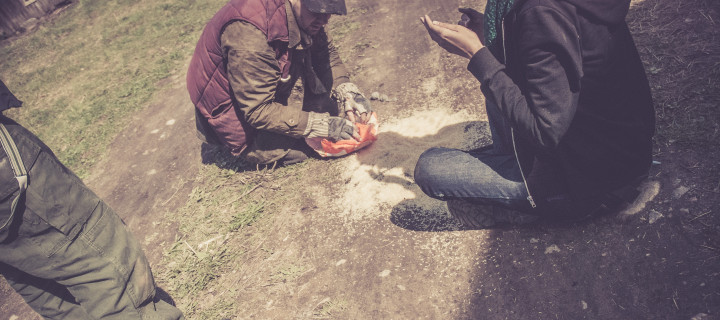In the year 2013, the Swedish midsummer idyll is shattered to pieces when Russia suddenly attacks. A war without winners commences, followed by the deadly epidemic called Rosen (the Rose). In refugee camps around the country, tens of thousands die from starvation, violence and sickness. Three years after that first fatal bombing night, the gates to Kolsjön’s refugee camp finally fall and a small group of survivors find their way out into what was once Sweden.
 Thus begins Berättelsefrämjandet’s Hinterland, the most recent larp of the Solnedgång campaign. I participated in the second run of two, together with 45 other larpers who also decided that a “hardcore sandbox larp in a post-apocalyptic setting” was just right (although that might sound intimidating, several first time larpers participated and reportedly had a blast). However, I’d rather like to create the new category called “survival larp,” and label Hinterland as that.
Thus begins Berättelsefrämjandet’s Hinterland, the most recent larp of the Solnedgång campaign. I participated in the second run of two, together with 45 other larpers who also decided that a “hardcore sandbox larp in a post-apocalyptic setting” was just right (although that might sound intimidating, several first time larpers participated and reportedly had a blast). However, I’d rather like to create the new category called “survival larp,” and label Hinterland as that.
The instructions from the organizers were clear: don’t bring stuff! The entire packing list encompassed a water bottle, something to eat out of, and possibly some personal memorabilia. Food had to be found in-game, as did sleeping gear and heat sources. After the first run of the larp, the amount of findable food had been adjusted and reduced to make it too scarce for everyone to be fed at the same time. The strong or the cunning survived.
The safety aspect was of course carefully planned on the organizers’ part. For example, there was always enough water for everyone, and sandwiches and a bed in the off-game house. Just knowing this existed calmed a lot of people, and for me it meant that I never had to use it: I was perfectly safe in knowing that the option was there while we tested new larp limits.
Thou Shalt Readily Steal
One of the strongest taboos of all in larping is to never steal people’s food or sleeping gear. Hinterland went outside the box even here and encouraged stealing these things in order to emphasize the sense of scarcity, vulnerability, and exposure. Before the larp, several participants mentioned how hard it was going to be to steal someone’s food or let someone freeze at night. What helped me in momentarily shutting down my off-game moral compass was the common agreement we’d all accepted when signing up for the larp. We were prepared for rough times, for being hungry and cold, and we wanted to experience that.
 During the larp, there was indeed some sneaking and stealing, but I think it could have been expanded even further. One culprit turned out to be, somewhat surprisingly, the Swedish freedom to roam. It was clear that this part of Swedish culture provides us with knowledge and access to food at all times without us considering it as special, something that one of the foreign participants noted in wonder:
During the larp, there was indeed some sneaking and stealing, but I think it could have been expanded even further. One culprit turned out to be, somewhat surprisingly, the Swedish freedom to roam. It was clear that this part of Swedish culture provides us with knowledge and access to food at all times without us considering it as special, something that one of the foreign participants noted in wonder:
And then I saw people starting to pick grass, and I thought that I hope they’re not going to eat… Yes, they’re eating it.
Another culprit was the “niceness trap”, which was discussed briefly prior to the larp albeit hard to avoid. It’s much nicer if everyone is happy: we are supposed to share, we are supposed to meta-think that it will be too much for someone if they don’t get lunch. A big push in the right, individualistic direction came when a group of raiders robbed us of everything they could find – including the iron stove in one of the houses! When 46 people own 3 blankets instead of 50, the situation is suddenly quite different.
Control of the Sandbox
The larp was labelled as sandbox, i.e. very little control and guidance came from the organizers, while the participants were free to create the story they wanted. The location itself also offered “physical sandboxing” as several houses set for full renovation, entailing lots of scrap, were at the larpers’ disposal. To be able to break windows, smash furniture, and steal anything not nailed down really added to the immersion in a larp like this.
 While it can be really hard as an organizer to let players be “bored” during a larp, this was crucial to the Hinterland experience. Long periods of downtime and a low-speed larp in general offered both opportunities for processing, fine-tuned play and internal misery. Also, downtime made the action-filled elements much stronger as they became a sudden contrast to the low pace. A few occurrences of NPC groups (Non-Player Characters) appeared to stir the player pot, where the example of raiders has been mentioned above and others were the national forces or neighbouring farmers.
While it can be really hard as an organizer to let players be “bored” during a larp, this was crucial to the Hinterland experience. Long periods of downtime and a low-speed larp in general offered both opportunities for processing, fine-tuned play and internal misery. Also, downtime made the action-filled elements much stronger as they became a sudden contrast to the low pace. A few occurrences of NPC groups (Non-Player Characters) appeared to stir the player pot, where the example of raiders has been mentioned above and others were the national forces or neighbouring farmers.
The use of dogs as a terror and power aspect with the NPCs worked excellently. It’s a physical trigger both visibly and audibly, and at the same time it touches upon fears tied to survival even off-game. Naturally, the dogs must be well trained and the players must act safely around them at all times. Hinterland had clear rules regarding this. The character creation process also included a common memory for all characters of leaving the camp and getting past the guard dogs, which made the dogs easy and believable triggers that enabled strong play.
There was some guidance apart from the NPC elements. A small number of players from run 1 participated during run 2 with the explicit function of being able to escalate the play or increase hardships if the story became too “cozy”. Their characters could also vanish from play earlier than Sunday, which I think gave a deeper emotional game than otherwise, since people lost friends and were simultaneously reminded that no one was safe. The organizers had instructed us in the dramaturgic curve of the larp as well, which ranged from cooperation during Friday to breakdown during Sunday. That aided me in steering some of the choices I made, even if that was a more subtle kind of guidance.
1, 2, 3, Gulp!
 A large part of the larp circulated around the deadly disease Rosen. To determine who was infected during the course of the weekend, the organizers had created a system of “disease pills”. At run 2, we got three pills each to be taken continuously on Saturday. If the pill contained sugar, we were healthy, but if it contained salt, we had been infected. It was up to us as players to determine how fast we wanted to act out the passage of the disease and if we wanted our characters to die on Sunday. According to the organizers, 10 out of the 46 participants were randomly selected for infection, and I was one of them.
A large part of the larp circulated around the deadly disease Rosen. To determine who was infected during the course of the weekend, the organizers had created a system of “disease pills”. At run 2, we got three pills each to be taken continuously on Saturday. If the pill contained sugar, we were healthy, but if it contained salt, we had been infected. It was up to us as players to determine how fast we wanted to act out the passage of the disease and if we wanted our characters to die on Sunday. According to the organizers, 10 out of the 46 participants were randomly selected for infection, and I was one of them.
The pills didn’t exist in-game; they were a meta thing only added for guiding the game. I took my first pill with tense expectation; it felt fun in the same way as opening a lottery ticket does. Sugar! My second pill, a few hours later, was taken with palpable anxiety and clenched stomach. Salt. Instinctively, I tried to deny the taste up until the capsule broke and the entire dosage fell out on my tongue. As I had decided not to play sick prior to the game, this was a surprising turn for me that, thanks to its quite physical instruction, really gave me the entire journey from denial to despair – and death. I can definitely see this technique being used in other situations where a “higher power” randomly decides the outcome of characters.
The Mental Steps
For a larp with such heavy themes as Hinterland’s, pre- and post- work is important. On Friday, there were mandatory workshops focused on character identity and physical play, as well as a measure of relation building. Afterward, a few of us discussed the lack of more psychological play in workshops. Today, physical play gets more and more incorporated in most larps, including a pre-set basic level of it. Even at larps where the focus is not on physical violence, it usually gets a disproportionate amount of time during workshops. Techniques for psychological oppression, on the other hand, are scarcely represented in instructions and exercises despite the fact that they offer great depth for characters and relations. During Hinterland, which was a low-speed larp as opposed to an action larp, more psychological play between characters would have fit perfectly.
 After the larp, a mandatory longer debrief was held for all participants. The motivation that even if you yourself don’t need a debrief, you’ve been part of someone else’s story that might need debriefing, was spot-on to me. My view of the debrief techniques was that they emanated from the thought that one had had a very strong experience during the larp and that one had to return step by step. This didn’t suit everyone, but better to originate with those who need it most than least. On the other hand, several participants felt stressed by having to stay while they themselves were not comfortable with the debrief methods. That might have been remedied by presenting more info on this before the larp, and a more structured organization of the clean-up that followed after debrief. To be able to start fiddling with things gives a sense of doing something relevant and not just waiting.
After the larp, a mandatory longer debrief was held for all participants. The motivation that even if you yourself don’t need a debrief, you’ve been part of someone else’s story that might need debriefing, was spot-on to me. My view of the debrief techniques was that they emanated from the thought that one had had a very strong experience during the larp and that one had to return step by step. This didn’t suit everyone, but better to originate with those who need it most than least. On the other hand, several participants felt stressed by having to stay while they themselves were not comfortable with the debrief methods. That might have been remedied by presenting more info on this before the larp, and a more structured organization of the clean-up that followed after debrief. To be able to start fiddling with things gives a sense of doing something relevant and not just waiting.
The function of “debrief buddies” becomes more frequent in relation to larps nowadays, and is a technique I appreciate. Many along with me find it hard to tell how they were affected immediately after the larp ends, and the worst bleed often appears a few days later. To have a check-up booked with someone who was there is something I find sensible and is a safety aspect I welcome. However, I’m not sure that I think that debrief buddies should be appointed randomly, as they were here, considering that the mission is to handle heavier reactions (which means a kind of exposure). On my part, I’d like to have someone I at least interacted with during the larp, in order to have a sense of who the other person is in our common context.
Effects After the Game
 It’s fascinating how much you can let yourself be affected during just one weekend. It helps, of course, to be mentally prepared, to go with the idea of experiencing vulnerability and harsh living conditions. Still, many reactions turned out surprisingly strong afterwards, especially when it came to food and property.
It’s fascinating how much you can let yourself be affected during just one weekend. It helps, of course, to be mentally prepared, to go with the idea of experiencing vulnerability and harsh living conditions. Still, many reactions turned out surprisingly strong afterwards, especially when it came to food and property.
When you’ve been on your knees in the gravel picking up seeds of rice fallen out of the raiders’ stolen goods, when you’ve gone to sleep with a piece of a curtain as a blanket, when you’ve lost everything you owned and realize that the most important item was the broken bottle you used for water… Then, other perspectives suddenly become apparent in our off-game Sweden.
I see how the gas station screams at me with hundreds of labels and items, how the servings at the restaurant are enormous and how we throw away that which could have fed lots of people for days. I realize how many things I own that have no value when it comes to survival. And how safe we are, really, in this society we were lucky enough to arrive in. I’m ashamed by the privilege of being able to “pretend” to suffer and live rough during a short while, just to return to my own reality without persecution, war, and hate.
And at the same time, I’m eternally grateful for all the insights I gain, because that makes me better, makes me be better as a person in a world where resources really are too few and far between. I think that for each person who goes through a larp like Hinterland, the level of understanding in the world increases a little. And that, dear fellow larpers, is huge.
Hinterland
Credits: Main designers and producers were Olle Nyman, Sebastian Utbult & Erik Stormark, for Berättelsefrämjandet. Co-produced by Karin Edman & Simon Svensson, with the help of Andreas Sigfridsson, Helen Stark and Ida Eberg.
Date: May 8–10, 2015 & May 22–24, 2015
Location: Private land (abandoned 19th century farm) near Kopparberg, Sweden
Length: 40 hours of play, 3–4 hours of workshop (per run)
Players: 83 (max 50 per run) + NPCs
Budget: ~€7,000 (Proceeds were donated to Ingen människa är illegal/No One is Illegal)
Participation Fee: €50–€250 (depending on income), €80 for a standard ticket
Game Mechanics: Honor System, playing to lose, safewords, pre-larp workshop, act structure, blank-firing firearms & blank weapons, meta-techniques (opt in).
Website: http://beratta.org/hinterland
Trailer:
Cover photo: Players scraping up spilled rice from the ground (play, Olle Nyman). Other photos by Sebastian Utbult and Olle Nyman.







